332SHARES
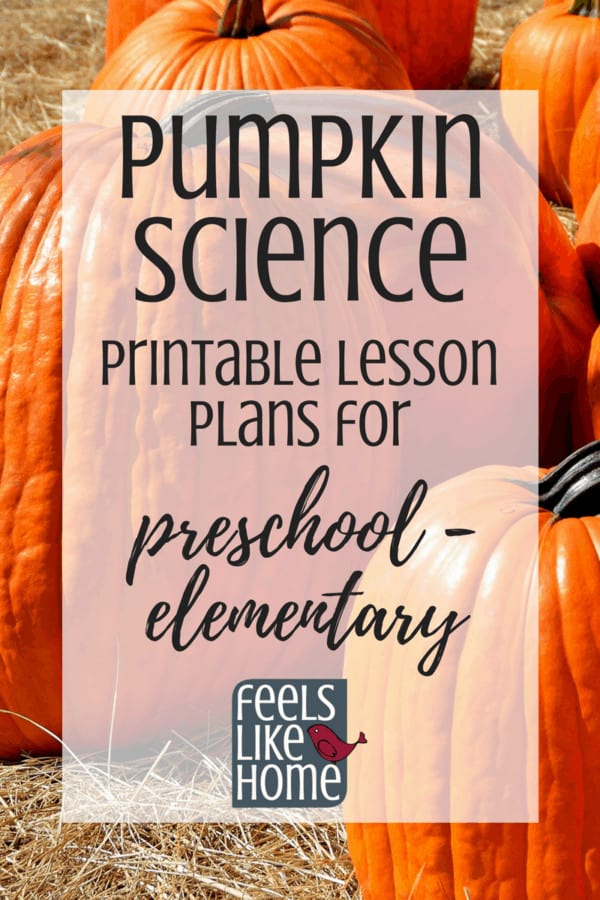
Last week, Strite\’s Farm Store (the local orchard and farm market that we frequent, year round) had about twenty different kinds of pumpkins, gourds, and squash.
I had to pace myself not to buy one of every single variety, just for fun.
I was thinking that pumpkins would make great, seasonally appropriate science lessons and that Grace would enjoy investigating all different kinds of pumpkins to see how they\’re alike and different.
I purchased a Hubbard squash, a neck pumpkin, 2 big old jack-o-lantern pumpkins (because Grace wanted one for carving and I wanted one for investigating), a turban pumpkin, a little dark orange almost red flattened out pumpkin, a huge white pumpkin, and a few whose descriptions are more complicated.
All that plus apples for our taste test for $20. I was thrilled to see my biweekly allowance spent on science!
Sunday was a beautiful day. The girls and I were outside on the deck where all the pumpkins are awaiting their grizzly fates. Grace picked up the neck pumpkin and began to play with it. I don\’t think she knew what it was, beyond an oddly shaped something-or-other.
Here is a great explanation and description of neck pumpkins, if you\’ve never seen one. Apparently, they\’re particular to south central Pennsylvania.


I asked Grace if she wanted to investigate the pumpkin.
Do all kids get excited about the word investigate? Grace was practically giddy.
\”YES!\” She squealed. \”Let\’s investigate the neck pumpkin!\”
We all sat down and felt the pumpkin all over. We talked about the stem end, where the pumpkin attached to the plant, and the blossom end, where the flower was pollinated and grew this big seed-protecting neck pumpkin.
We also knocked on the pumpkin, and we learned that the neck sounds hollow while the round bottom sounds solid.
When we\’d sufficiently investigated the outside of the pumpkin, I made the first cut, just above the bulby part.
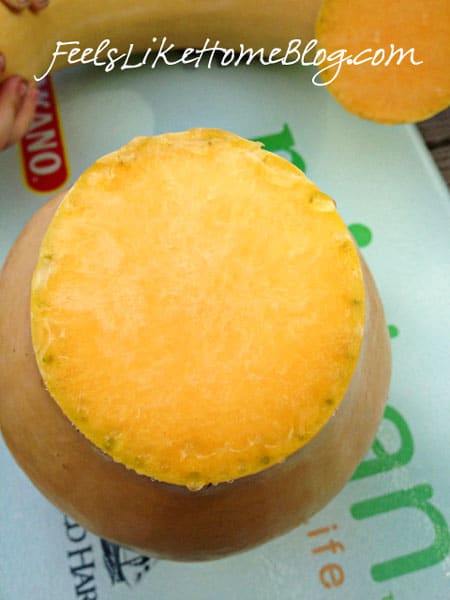

Instantly, the pumpkin flesh began to weep. We talked about how there is water in the cells of the pumpkin and how it comes out because we cut the cells open. I don\’t know if she understood this part or not, but at least she\’s heard the terms once.
Both girls liked feeling the slimy pumpkin and tried to pierce it with their fingernails.
Next up, slice the bulby part. I was expecting a hollow-ish pumpkin, but that\’s not what we found.
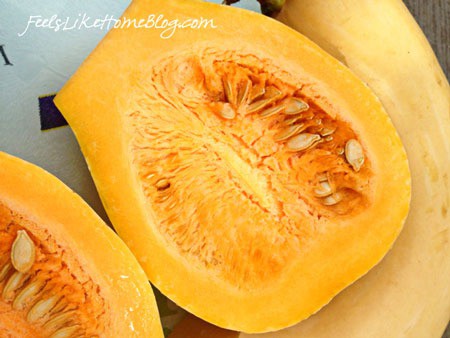

Grace felt the insides and decreed that they felt like spaghetti but were softer and a little squishy.
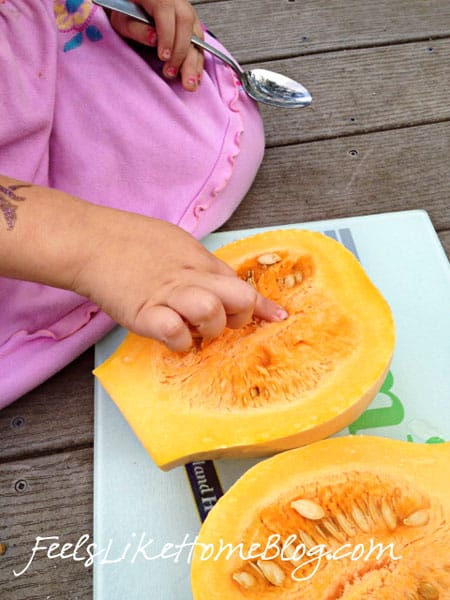

My eventual goal was roasting and cooking the neck pumpkin, so after Grace had sufficiently investigated the pumpkin, I gave her a spoon and told her that we had to scoop out the seeds in order to cook the pumpkin.
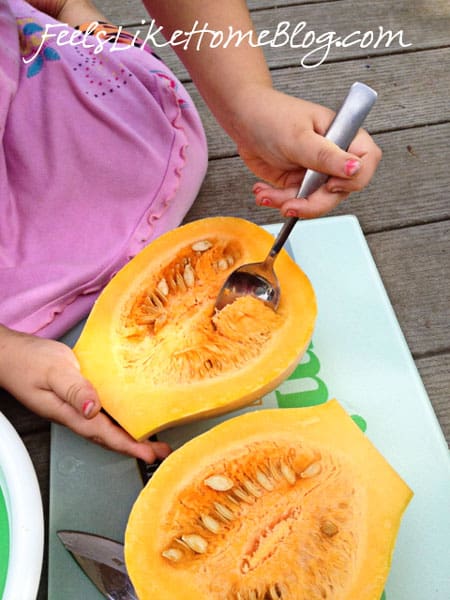

As happens with most of my brilliant teachable moments, she scooped for five seconds and then left me to do the rest. Once I had all the pumpkin guts in a bowl, Allie came along and poked around in them for a little while.
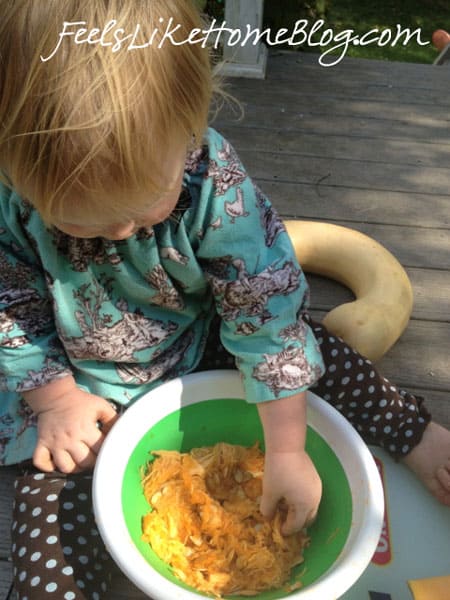

Allie stayed only a few minutes to play in the squishy mess, even though she\’s normally really into squishy messes. I think she didn\’t like the smell. Pumpkin guts have a very strong and distinct odor. I don\’t enjoy it, either.
Both girls breezed through after I had all the guts scooped out to feel the pumpkin bowls leftover.
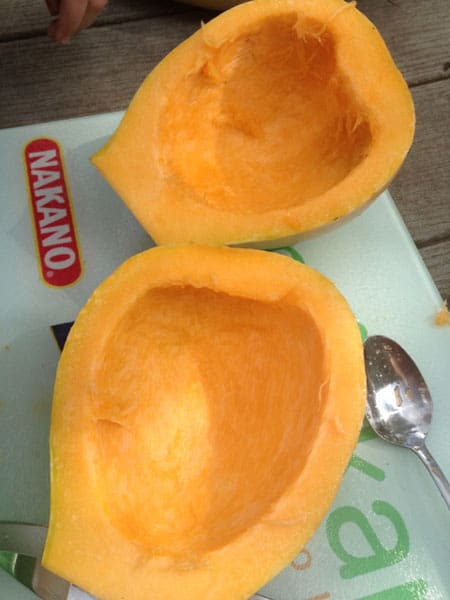

We picked through the pumpkin guts to find all the seeds (which we caramelized).
Some people say you shouldn\’t eat science investigations, but I have a huge problem wasting food. I rinsed the pumpkin off and roasted it for use in recipes.
Pumpkin books for kids
- The Pumpkin Book – I think this is the best non-fiction book on the list. It talks about everything from the pumpkin life cycle to how pumpkins played a part in the first Thanksgiving.
- Seed, Sprout, Pumpkin, Pie – This gorgeously photographed book by Nat Geo Kids talks about the pumpkin life cycle, the uses of pumpkins, and all kinds of interesting pumpkin facts.
- From Seed to Pumpkin – This book also has great illustrations. It features all of the same pumpkin facts as the two books above, but this one also has experiments and activities that kids can do with their pumpkins.
- Pumpkin Circle: The Story of a Garden – This simple little book focuses just on the pumpkin life cycle with beautiful photographs. It invites the reader to become the pumpkin farmer, growing his or her own pumpkin by following the instructions at the end of the book.
- The Legend of Spookley the Square Pumpkin – This is a cute little story about a pumpkin who hatched as a square. Or really, he\’s a rectangular prism, but let\’s not get technical.
- Pumpkin Jack – This is about a little boy and the jack-o-lantern he carved for Halloween. As all jack-o-lanterns do, the pumpkin starts to rot, and the little boy watches it undergo many changes as the days tick by. If I were buying only one book about pumpkins, I think I would buy this one. It\’s a totally fictional story that teaches all about real science in a very subtle way.
- The Runaway Pumpkin – This is a silly story about the biggest pumpkin some kids have ever seen, and what happens when it escapes and rolls away.
- The Roll-Away Pumpkin – This is another fun story about a big pumpkin that goes rolling away down a hill and takes the entire village to catch. This one rhymes and has beautiful illustrations.
- How Big Could Your Pumpkin Grow? – This one uses something from real life – pumpkins growing ever bigger and more amazing – and turns it into something fanciful and absurd. It has lots of great vocabulary (so many synonyms for big!), and it includes landmarks from across America, like the Grand Canyon and the Brooklyn Bridge.
- How Many Seeds in a Pumpkin? – I love this one; it\’s perfect for my math and science lesson plan below. It is all about a classroom where the students are investigating pumpkins, estimating and counting seeds, and slopping in pumpkin guts.
Grab the full pumpkin science lesson plan including lots more science investigation ideas, plus math, literacy, and other connections.
Looking for more pumpkin goodness?
- Here\’s an old post on how to cook a fresh pumpkin.
- My Pumpkin Recipes board on Pinterest
- My favorite pumpkin recipes are pumpkin pie pancakes and pumpkin pie with pecan topping
We\’re going to use the same procedure to investigate the other pumpkins and squashes that I got, maybe 1 or 2 a week.
332SHARES





